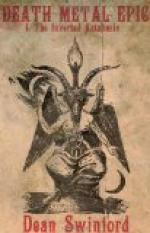AMERICAN EPICS
When Europeans first landed on this continent, they found it occupied by various tribes of Indians, speaking—it is estimated—some six hundred different languages or dialects. At first no systematic effort could be made to discover the religion or traditions of the native Americans, but little by little we have learned that they boasted a rich folk-lore, and that their nature-myths and hero-tales were recited by the fireside from generation to generation. Because there were tribes in different degrees of evolution between savagery and the rudimentary stages of civilization, there are more or less rude myths and folk-tales in the samples with which we have thus become familiar.
Among the more advanced tribes, Indian folk-lore bears the imprint of a weirdly poetical turn of mind, and ideas are often vividly and picturesquely expressed by nature similes. Some of this folk-lore is embodied in hymns, or what have also been termed nature-epics, which are now being carefully preserved for future study by professional collectors of folk-lore. Aside from a few very interesting creation myths and stories of the Indian gods, there is a whole fund of nature legends of which we have a characteristic sample in Bayard Taylor’s Mon-da-min, or Creation of the Maize, and also in the group of legends welded into a harmonious whole by Longfellow in the “American-Indian epic” Hiawatha.
The early European settlers found so many material obstacles to overcome, that they had no leisure for the cultivation of literature. Aside from letters, diaries, and reports, therefore, no early colonial literature exists. But, with the founding of the first colleges in America,—Harvard, Yale, William and Mary, the College of New Jersey, and King’s College (now Columbia),—and with the introduction of the printing press, the American literary era may be said to begin.
The Puritans, being utterly devoid of aesthetic taste, considered all save religious poetry sinful in the extreme; so it was not until the middle of the seventeenth century that Fame could trumpet abroad the advent of “the Tenth Muse,” or “the Morning Star of American Poetry,” in the person of Anne Bradstreet! Among her poems—which no one ever reads nowadays—is “An Exact Epitome of the Three First Monarchies, viz., the Assyrian, Persian, and Grecian, and the Beginning of the Roman Commonwealth to the End of their Last King,” a work which some authorities rank as the first American epic (1650). This was soon (1662) followed by Michael Wigglesworth’s “Day of Doom,” or “Poetical Description of the Great and Last Judgement,” wherein the author, giving free play to his imagination, crammed so many horrors that it afforded ghastly entertainment for hosts of young Puritans while it passed through its nine successive editions in this country and two in England. Although devoid of real poetic merit, this work never failed to give perusers “the creeps,” as the following sample will sufficiently prove:




